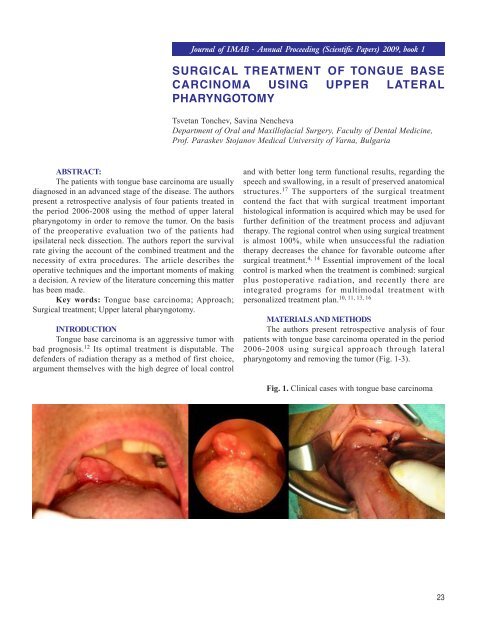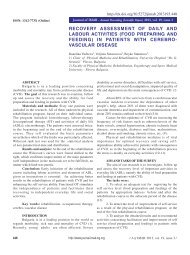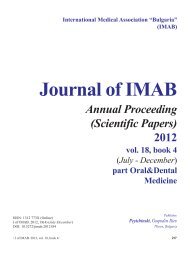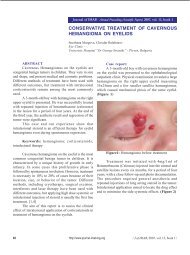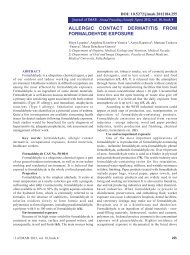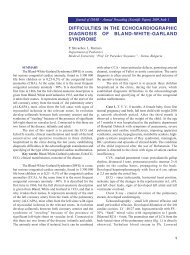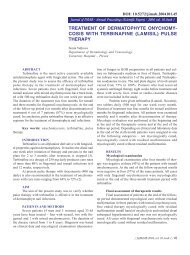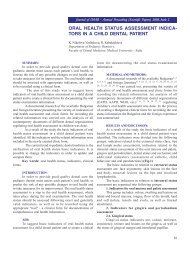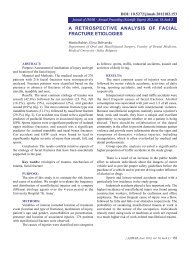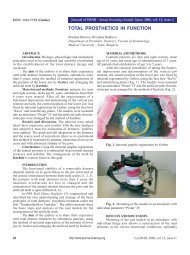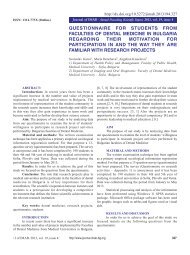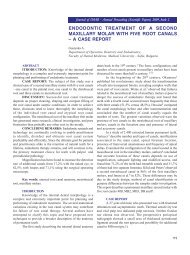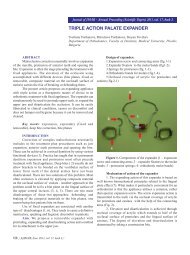Page: 23-25; FULL TEXT - Journal of IMAB
Page: 23-25; FULL TEXT - Journal of IMAB
Page: 23-25; FULL TEXT - Journal of IMAB
Create successful ePaper yourself
Turn your PDF publications into a flip-book with our unique Google optimized e-Paper software.
<strong>Journal</strong> <strong>of</strong> <strong>IMAB</strong> - Annual Proceeding (Scientific Papers) 2009, book 1<br />
SURGICAL TREATMENT OF TONGUE BASE<br />
CARCINOMA USING UPPER LATERAL<br />
PHARYNGOTOMY<br />
Tsvetan Tonchev, Savina Nencheva<br />
Department <strong>of</strong> Oral and Maxill<strong>of</strong>acial Surgery, Faculty <strong>of</strong> Dental Medicine,<br />
Pr<strong>of</strong>. Paraskev Stojanov Medical University <strong>of</strong> Varna, Bulgaria<br />
ABSTRACT:<br />
The patients with tongue base carcinoma are usually<br />
diagnosed in an advanced stage <strong>of</strong> the disease. The authors<br />
present a retrospective analysis <strong>of</strong> four patients treated in<br />
the period 2006-2008 using the method <strong>of</strong> upper lateral<br />
pharyngotomy in order to remove the tumor. On the basis<br />
<strong>of</strong> the preoperative evaluation two <strong>of</strong> the patients had<br />
ipsilateral neck dissection. The authors report the survival<br />
rate giving the account <strong>of</strong> the combined treatment and the<br />
necessity <strong>of</strong> extra procedures. The article describes the<br />
operative techniques and the important moments <strong>of</strong> making<br />
a decision. A review <strong>of</strong> the literature concerning this matter<br />
has been made.<br />
Key words: Tongue base carcinoma; Approach;<br />
Surgical treatment; Upper lateral pharyngotomy.<br />
INTRODUCTION<br />
Tongue base carcinoma is an aggressive tumor with<br />
bad prognosis. 12 Its optimal treatment is disputable. The<br />
defenders <strong>of</strong> radiation therapy as a method <strong>of</strong> first choice,<br />
argument themselves with the high degree <strong>of</strong> local control<br />
and with better long term functional results, regarding the<br />
speech and swallowing, in a result <strong>of</strong> preserved anatomical<br />
structures. 17 The supporters <strong>of</strong> the surgical treatment<br />
contend the fact that with surgical treatment important<br />
histological information is acquired which may be used for<br />
further definition <strong>of</strong> the treatment process and adjuvant<br />
therapy. The regional control when using surgical treatment<br />
is almost 100%, while when unsuccessful the radiation<br />
therapy decreases the chance for favorable outcome after<br />
surgical treatment. 4, 14 Essential improvement <strong>of</strong> the local<br />
control is marked when the treatment is combined: surgical<br />
plus postoperative radiation, and recently there are<br />
integrated programs for multimodal treatment with<br />
personalized treatment plan.<br />
10, 11, 13, 16<br />
MATERIALS AND METHODS<br />
The authors present retrospective analysis <strong>of</strong> four<br />
patients with tongue base carcinoma operated in the period<br />
2006-2008 using surgical approach through lateral<br />
pharyngotomy and removing the tumor (Fig. 1-3).<br />
Fig. 1. Clinical cases with tongue base carcinoma<br />
<strong>23</strong>
Fig. 2. Surgical approach to the base <strong>of</strong> tongue<br />
(according to B. Baily 3 )<br />
which determined stage III and IVA <strong>of</strong> the disease. After x-<br />
ray there was no evidence for clinically notable metastasis<br />
(Tab. 1). The lab blood tests were in norm.<br />
¹<br />
stage<br />
Age Sex T N M Clinical<br />
1. 56 M 1 1 0 III<br />
2. 68 M 1 2 0 IVA<br />
3. 73 M 1 0 0 I<br />
4. 78 F 1 0 0 I<br />
Tab. 1. Distribution <strong>of</strong> patients by age, sex and TNM<br />
criteria<br />
All the patients underwent surgical resection <strong>of</strong> the<br />
primal tumor using approach through upper lateral<br />
pharyngotomy and with two <strong>of</strong> them the method was<br />
combined with ipsilateral neck dissection during the same<br />
operation (Tab. 2). After interdisciplinary discussion all <strong>of</strong><br />
the patients underwent postoperative radiation therapy.<br />
¹ Surgical Histological Compli- Follow up Status<br />
treatment result cation (months)<br />
1. TR+RND SCC No 18 DOD<br />
2. TR+RND SCC No 9 DPD<br />
3. TR SCC No <strong>25</strong> A<br />
4. TR SCC No 10 A<br />
Fig. 3. Intraoperative view in our case<br />
The average age <strong>of</strong> the patients is 68,5 years<br />
(between 56 and 77). Three <strong>of</strong> them are male and one female.<br />
On the basis <strong>of</strong> the clinical finding and the tests made the<br />
patients were staged in accordance with the criteria <strong>of</strong> the<br />
American Joint Committee on Cancer. 2 At admission two <strong>of</strong><br />
the patients were with enlarged lymph nodes <strong>of</strong> the neck<br />
Tab. 2. Surgical treatment modalities, results and<br />
survival in our patients<br />
(Abbreviations: TR – tumor resection; RND – radical<br />
neck dissection; SCC – squamous cell carcinoma; DOD –<br />
death from other disease; DPD – death from progression <strong>of</strong><br />
the disease)<br />
RESULTS<br />
In the early postoperative period there were no notable<br />
complications <strong>of</strong> systemic or local character. The patients<br />
have been put naso-gastric tube preoperatively which was<br />
removed 5 days after surgery when the capability for<br />
swallowing was available. None <strong>of</strong> the patients had serious<br />
disturbances in the breathing process that would force the<br />
need <strong>of</strong> tracheotomy. The follow-up period is between 9 and<br />
<strong>25</strong> months (15,5 average). To the present moment two <strong>of</strong> the<br />
patients are alive; one is deceased from different cause, not<br />
related with oncological disease, and one has died as a result<br />
<strong>of</strong> progression <strong>of</strong> the main oncological disease. The last<br />
patient was determined with local persistence <strong>of</strong> the tumor<br />
process and the development <strong>of</strong> distant metastasis four<br />
months after surgery.<br />
24
DISCUSSION<br />
The principles <strong>of</strong> tongue base carcinoma treatment<br />
undergo heterogeneous development over the last few<br />
years. The successful treatment is complicated by the fact<br />
that most <strong>of</strong> the cases with such tumors are usually without<br />
symptoms until relatively late stage, which leads to prevail<br />
over much advanced cases with high frequency <strong>of</strong> neck<br />
metastasis. Although the progress <strong>of</strong> the therapeutic<br />
strategies and the improved opportunities for local control<br />
the overall survival rate has not increased much. The data<br />
regarding the use <strong>of</strong> operative treatment alone are few. The<br />
retrospective analysis shows that few are the patients that<br />
have been directed at an early stage <strong>of</strong> the disease, while<br />
the patients in advanced stage are usually treated with<br />
radiation therapy. With the surgical treatment the local<br />
control <strong>of</strong> the primal lesions at an early stage is between<br />
74% and 100%, while with patients in advanced stage is<br />
between 22% and 27%. 5, 6, 13, 15-17 The fact was also<br />
confirmed by our results. The regional control varies<br />
between 89% and 100% for No, from 50% to 75% for N1<br />
and less than 50% for N2. 6, 13 The combination <strong>of</strong> resection<br />
<strong>of</strong> the tumor and neck dissection when needed and<br />
postoperative radiation therapy is proven to increase the<br />
degree <strong>of</strong> local control compared with the separate<br />
application <strong>of</strong> one <strong>of</strong> the two methods. 8, 10, 14, 17 The<br />
functional results after surgical treatment are considerably<br />
worsened depending on the size <strong>of</strong> the primal tumor, due to<br />
the radical resection <strong>of</strong> the tumor mass and may lead to<br />
irreversible functional disorders. Although the improved<br />
regional control <strong>of</strong> the disease most <strong>of</strong> the patients die as a<br />
result <strong>of</strong> distant metastasis, developing in 13-16% <strong>of</strong> the<br />
cases, as particularly high risk are the cases with advanced<br />
local process and regional metastasis.<br />
1, 6, 7, 9, 11, 13, 17<br />
CONCLUSION<br />
The interdisciplinary approach has been forced at the<br />
up-to-date treatment <strong>of</strong> tongue base carcinoma. The decision<br />
for every single case has been evaluated depending on the<br />
overall condition <strong>of</strong> the patient and the stage <strong>of</strong> the disease.<br />
Through combined surgical and radiation therapy the results<br />
are much improved in the early stages while for advanced<br />
cases the results <strong>of</strong> the combination are disputable.<br />
BIBLIOGRAPHY<br />
1. Alvi A, J. Johnson. Development <strong>of</strong><br />
distant metastasis after treatment <strong>of</strong><br />
advanced-stage head and neck cancer. Head<br />
Neck 1997;19:500–505.<br />
2. American Joint Committee on<br />
Cancer: Pharynx (including base <strong>of</strong> tongue,<br />
s<strong>of</strong>t palate, and uvula). In: AJCC Cancer<br />
Staging Atlas. Greene, F, Compton, C,<br />
Fritz, A, Shah, J, Winchester D, editors.<br />
New York; Springer; 2006: 27–40.<br />
3. Baily B, Surgey for cancer (T1 and<br />
T2) <strong>of</strong> the midline tongue base. In: Surgery<br />
<strong>of</strong> the oral cavity. Chicago; Year book<br />
medical publishers; 1989:67.<br />
4. Calais G, et al. Squamous cell<br />
carcinoma <strong>of</strong> the base <strong>of</strong> the tongue: results<br />
<strong>of</strong> treatment in 115 cases. Br J Radiol<br />
1989;62:849–853.<br />
5. Dupont J, O. Guillamondegui, R.<br />
Jesse. Surgical treatment <strong>of</strong> advanced<br />
carcinomas <strong>of</strong> the base <strong>of</strong> the tongue. Am<br />
J Surg 1978;136:501–503.<br />
6. Foote R, et al. Base <strong>of</strong> tongue<br />
carcinoma: patterns <strong>of</strong> failure and<br />
predictors <strong>of</strong> recurrence after surgery alone.<br />
Head Neck 1993;15:300–307.<br />
7. Gourin C, J. Johnson, Surgical<br />
treatment <strong>of</strong> squamous cell carcinoma <strong>of</strong><br />
the base <strong>of</strong> tongue. Head Neck. 2001;<br />
<strong>23</strong>(8):653-60.<br />
8. Hinerman R, et al. External beam<br />
irradiation alone or combined with neck<br />
dissection for base <strong>of</strong> tongue carcinoma: an<br />
alternative to primary surgery.<br />
Laryngoscope 1994;104:1466–1470.<br />
9. Jaulerry C, et al. Results <strong>of</strong> radiation<br />
therapy in carcinoma <strong>of</strong> the base <strong>of</strong> the<br />
tongue. Cancer 1991;67:1532–1538.<br />
10. Lee H, et al. Long-term regional<br />
control after radiation therapy and neck<br />
dissection for base <strong>of</strong> tongue carcinoma. Int<br />
J Radiat Oncol Biol Phys 1997;38:995–<br />
1000.<br />
11. Machtay M, et al. Combined<br />
surgery and postoperative radiotherapy for<br />
carcinoma <strong>of</strong> the base <strong>of</strong> tongue: analysis<br />
<strong>of</strong> treatment outcome and prognostic value<br />
<strong>of</strong> margin status. Head Neck 1997;19:494–<br />
499.<br />
12. Mark A, et al. Functional Outcomes<br />
After Treatment <strong>of</strong> Squamous Cell<br />
Carcinoma <strong>of</strong> the Base <strong>of</strong> the Tongue. Arch<br />
Otolaryngol Head Neck Surg.<br />
2002;128:887-891.<br />
13. Nisi K, et al. Adjuvant radiotherapy<br />
for squamous cell carcinoma <strong>of</strong> the tongue<br />
base: improved local-regional disease<br />
control compared with surgery alone.<br />
International J Radiat Oncol Biol Phys<br />
1998; 41:371–377.<br />
14. Parsons J, R. Million, N. Cassisi.<br />
Carcinoma <strong>of</strong> the base <strong>of</strong> tongue: results <strong>of</strong><br />
radical irradiation with surgery reserved for<br />
irradiation failure. Laryngoscope<br />
1982;92:689–696.<br />
15. Spiro R, Strong E. Surgical<br />
treatment <strong>of</strong> cancer <strong>of</strong> the tongue. Surg<br />
Clin North Am 1074;54:759–765.<br />
16. Weber P, Myers E, Johnson J.<br />
Squamous cell carcinoma <strong>of</strong> the base <strong>of</strong><br />
tongue. Eur Arch Oto-rhino-laryngol<br />
1993;<strong>25</strong>0:63–68.<br />
17. Weber R, et al. Treatment selection<br />
for carcinoma <strong>of</strong> the base <strong>of</strong> tongue. Am J<br />
Surg 1990;160:415–419.<br />
Corresponding author:<br />
Dr. Tsvetan Tonchev, DMD, PhD<br />
Department <strong>of</strong> Oral and Maxill<strong>of</strong>acial Surgery, Faculty <strong>of</strong> Dental Medicine;<br />
Pr<strong>of</strong>. Paraskev Stojanov Medical University <strong>of</strong> Varna<br />
55 Marin Drinov street, BG-9002 Varna, Bulgaria<br />
E-mail: mfstonchev@mu-varna.bg<br />
<strong>25</strong>


